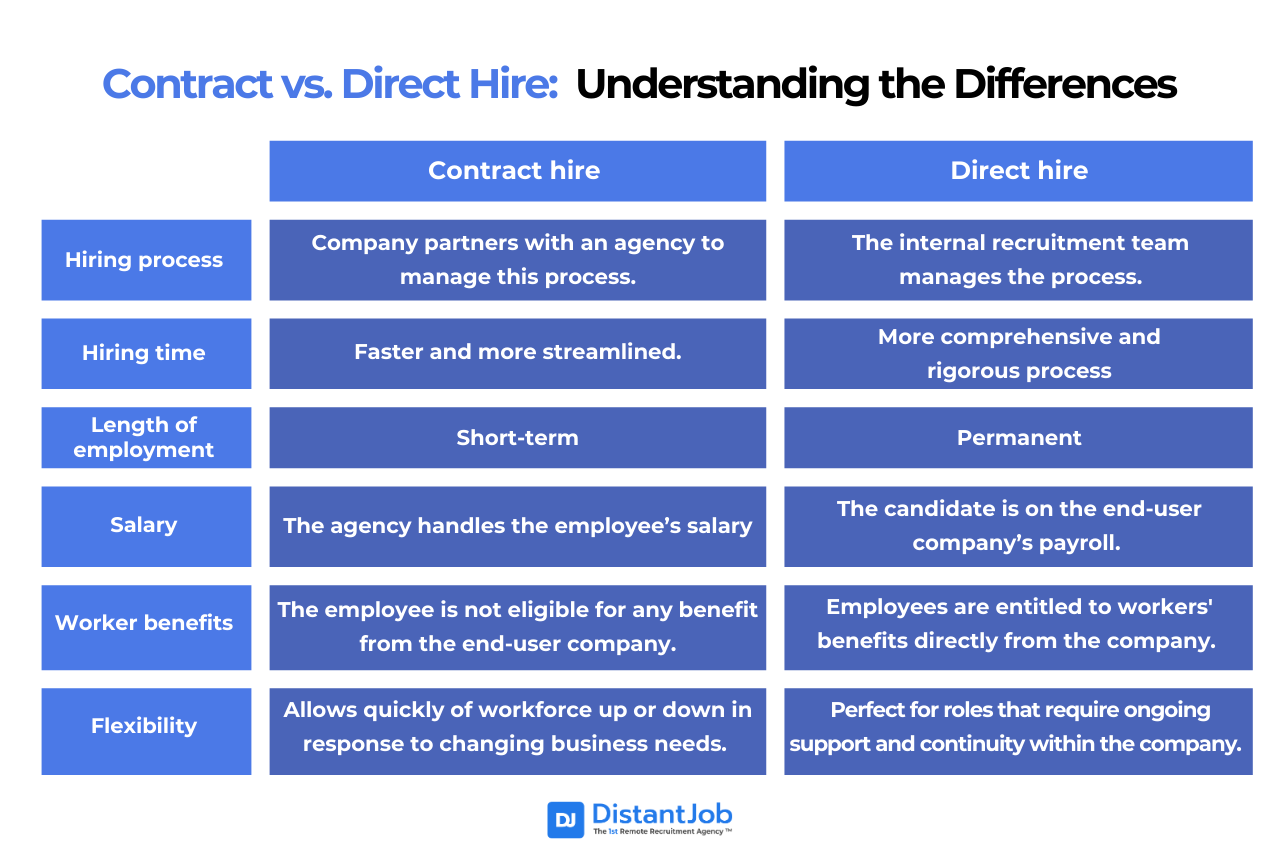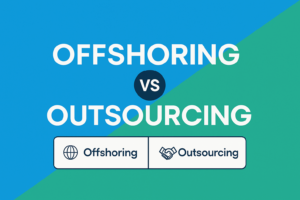There is nothing more important to any startup or SME than scaling their team without overspending. But as the company grows and costs become more of a concern, the choice between a direct hire and a contract workforce model can significantly impact scalability and flexibility. Direct hiring refers to the process of hiring a developer (yes, we will use developers as an example, as they are our bread and butter) directly as a full-time employee of your company and creates a closer relationship with your employee. Contract hire offers a more flexible relationship.
Our years of experience in remote tech recruitment have shown us that the key isn’t necessarily picking one model, but rather understanding the full range of hiring strategies available and how they can be tailored to your specific needs based on project duration, budget constraints, skill requirements, and your company’s growth plan.
In this article, we will evaluate, side by side, the differences between both models.
- A direct hire brings the advantages of commitment, loyalty, and investment in training.
- A contract hire offers a more cost-effective and flexible solution, better suited for short-term projects.
By the end of this article, you will be able to make an informed decision on which model best fits your budget, scaling goals, and flexibility needs.
What is Direct Hire?
Direct hire is when a company employs a candidate for a full-time, long-term position. Also called direct placement, this employment model offers employees a regular salary, paid time off, and other benefits. Employers can handle the entire direct hiring process. However, to speed up the time-to-hire, they can work with an IT recruitment company like DistantJob.
Pros of Direct Hiring
Direct hiring comes with many benefits. The biggest one is that direct hires have a 50% lower turnover rate compared to contractors within the first two years. Let’s dive in and see the other benefits:
Increased loyalty and engagement
Direct hire employees are more likely to be loyal and engaged with the company since they are part of the permanent team. Besides, many companies invest in the professional development of their permanent employees, which contributes to higher job satisfaction and commitment to the organization. According to research, 94% of employees stay longer with companies that invest in their development.
Promotes team cohesion and productivity
When employees are committed to their roles, they contribute to a positive, productive workplace. Your dev team will work to build rapport quickly if they know they’ll be working together in the long term.
Access to highly qualified candidates
Offering permanent positions attracts top-level candidates due to the level of job security it offers. This is especially true for passive candidates needing more incentives to leave their current jobs. For example, a senior developer will only leave their full-time employment for a permanent position.
Cost-effective in the long-term
Since the employee is on your payroll, you don’t need to pay the staffing agency monthly to keep them on their books. In addition, permanent employees have fewer turnovers, saving you money on recruitment and training costs in the long run.
Cons of Direct Hiring
While direct hiring saves you money in the long term, it requires a more significant investment in recruitment, onboarding, and initial training expenses. So it comes with several cons:
Longer time to fill positions
Unless you outsource this phase to a recruitment firm like DistantJob, it takes time and resources. Your internal team will have to conduct additional interview rounds, talent assessments, onboarding, and training — all of which can prolong the vacancy. This is especially true when trying to fill up tech roles, which take an average of 52 days.
Less flexibility
Since direct hires are permanent, they likely aren’t the best choice for project-based or seasonal work as business needs shift. Scaling your business up or down can be challenging if you exclusively rely on direct hires.
What is Contract Hire
Contract to hire is when an employer hires a candidate, usually through a staffing agency, for a short-term position with the possibility of full-time employment. During this period (usually 3-6 months), the employer will assess whether or not the employee is a good fit.
Pros & Cons of Contract Hiring
One of the main benefits of contract hiring is increased flexibility. Businesses can quickly scale their workforce up or down, adapting rapidly to changing market conditions, seasonal demands, or specific project needs.
By choosing contract staffing, you allow immediate access to specialized professionals who possess niche or advanced skills, which might be hard or costly to find through direct hiring. Lastly, the biggest benefit of all is cost, as companies can save up to 30% on hiring costs using contract staffing vs. direct hiring.
Working with contract staff also has its cons. It can increase the turnover rate and create legal complexities, especially concerning intellectual property (IP) ownership, confidentiality, and compliance with labor regulations.
Contract vs. Direct Hire: Understanding the Differences
While contract hire offers a faster and more flexible solution for short-term employment needs—often managed by an agency—direct hire is better suited for long-term roles that require deeper commitment and are typically handled internally.
The table below compares these two employment strategies, covering aspects like hiring process, time, length of employment, salary, benefits, and flexibility, to help you decide which approach aligns best with your organization’s goals.

Now that we know the difference between contract and direct hire, let’s see how they might play out in a real-life scenario.
How to Decide Between Contract and Direct Hire
To further understand their differences, let’s discuss when to use each hiring strategy for IT projects.
Contract Hire
You can use contract hire to adjust your staffing levels when a project’s requirements and timeline are uncertain. Say you’re building a new mobile payment app for a client. Then, midway through the project, the client changes the scope based on the latest market information. Suppose you lack the numbers to fulfill this new request. In that case, you can bring in developers on contract hire to support your team. At the end of the project, they leave, or you retain high performers.
Contract-to-hire developers can help manage workload during increased project volumes or seasonal demands without committing to long-term hires. For example, during holiday seasons or when launching a new product that requires additional hands on deck. If the product succeeds, you may change the status of the contractors to become full-time developers.
Direct Hire
Projects that require sustained effort and deep product knowledge can benefit from a stable, permanent team. For example, if you’re building a proprietary software product or platform, a dedicated in-house team is crucial for product evolution. In addition, direct hires can provide better control over data security.
Systems that require a deep understanding of business processes often benefit from having developers who have worked on them for an extended period. Full-time developers can also become knowledge repositories, ensuring the continuity of the organization’s expertise.
Contract-to-Hire vs Direct Hire: Key Factors to Consider When Choosing the Right Model
As a startup or SME, balancing cost efficiency with the need for scalable talent is critical.
By evaluating factors like cultural fit, budget constraints, and project duration, you can make a data-driven hiring decision that aligns with your growth trajectory and business goals.
Project Duration
If it is an ongoing project with a steady workload, then hiring developers permanently is the best option. It creates stability and ensures consistent progress without interruptions. Conversely, a short-term project that requires specific skills that aren’t needed long-term is better for contractors.
Budget
Direct hires usually involve high upfront costs from interviews, training, salary, and other benefits. However, with contract devs, you have more flexibility because you only pay for services rendered. Or, as in most cases, the staffing agency handles their payment. So, consider how much you’re willing to spend before deciding. In 2023, America’s staffing companies hired approximately 12.7 million temporary and contract employees which highlight the significant role that contract work plays in providing workforce flexibility for U.S. businesses.
Skill Requirement
Some projects require specialized skills that your team lacks. In those situations, hiring contractors with such skills is better, especially if it costs more to train existing employees.
However, if those skills can be easily acquired, make permanent hires and train your staff. It is an investment in your company’s long-term future.
Company Culture
Another factor to consider when deciding between an IT contractor and a full-time employee is cultural fit. Direct hires offer cultural stability as they fully integrate into the company culture. Meanwhile, contract workers might not be motivated to blend in since they are not permanent employees.
Future Growth
Consider how each hiring approach aligns with your long-term goals. Direct hires are an investment in your team’s growth and development. They foster a sense of loyalty and commitment, which leads to productivity and innovation.
Contract hires, on the other hand, provide flexibility to scale your team based on project needs. They allow you to save on costs and adjust to changing market demands.
So, evaluate your organization’s trajectory and objectives to decide which model suits you. And if this wasn’t clear enough to assist you in finding the solution maybe this flowchart will:
Conclusion
Contract and direct hire are effective strategies for finding developers or any type of employee you might need. These approaches are, however, different in their hiring process, length of employment, cost implications, and flexibility.
Ensure you choose one that aligns with your company and project goals. If you’re still unsure about the best option, book a call with us to learn more. We offer IT staffing solutions that connect companies like yours to global tech talent. Our elite tech recruiters analyze your project requirements and match you with expertly vetted software developers in 14 days or less – backed by our money-back guarantee. Every candidate is thoroughly screened to Silicon Valley standards, ensuring you get precisely the expertise your project needs. Plus, if you’re not 100% satisfied with your hire, we’ll find a replacement or refund you.





